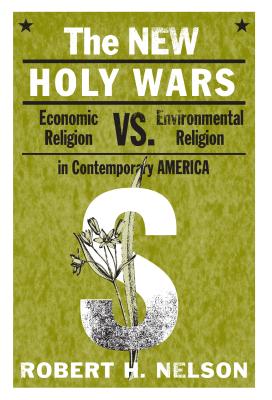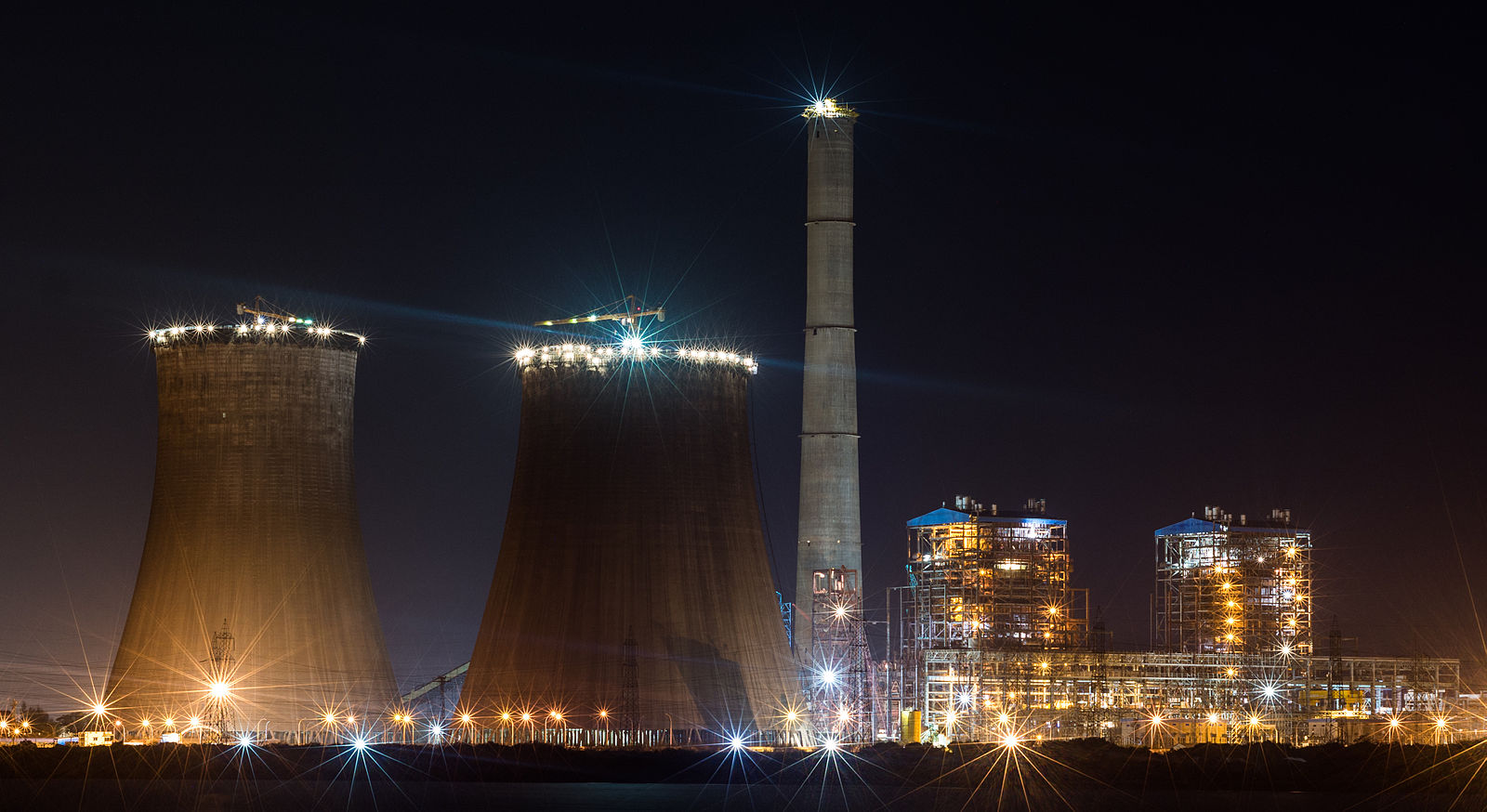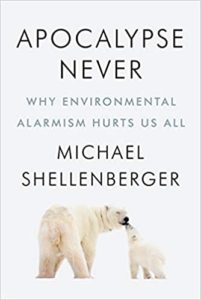Boise, ID. Every decade or so, a new charismatic figure rises up to proclaim that the sky is not falling. During my college days in the early 1990s, I was exposed to Dixy Lee Ray’s Trashing the Planet (1990) and to the king of the Cornucopians, Julian Simon. Simon’s best known of his many similar works was The Ultimate Resource (1981), and his last, published posthumously in 2000, was It’s Getting Better All the Time. Ray and Simon were reacting to the perceived excesses of gloom and doom activist scientists like Paul Ehrlich, Carl Sagan, Barry Commoner, and E.O. Wilson. Simon would inspire Bjorn Lomborg to pen The Skeptical Environmentalist in 1998. The black t-shirt loving Lomborg is still at it and even has a new book out called False Alarm. Yet, with the release of Apocalypse Never, Michael Shellenberger (his t-shirt is yellow and sports a gorilla) is making a run at becoming the right’s top contrarian environmentalist and a figure that the green left will love to hate. Longtime collaborator Ted Nordhaus, with whom Shellenberger penned Break Through: From the Death of Environmentalism to the Politics of Possibility in 2007, is now out of the picture completely (with nary a mention in the index or acknowledgments). By going solo, Shellenberger has seemingly left the domain of “ecomodernism” that he and Nordhaus helped to foster and has embraced Cornucopianism.
Apocalypse Never makes most of the same arguments that have been made by Lomborg, Simon, and Ray in the past, primarily: (1) Economic growth fueled by fossil fuels, nuclear power, and technology and is great for people; and (2) activists and the media exaggerate the risks of environmental problems and do so layered in hypocrisy. Often, authors in this genre play off of a specific foil. Simon had a famous wager with Ehrlich, an episode summarized and contextualized well in Paul Sabin’s 2013 book The Bet. Lomborg was featured in a 2010 film called Cool It that was very much modeled after An Inconvenient Truth. But Al Gore’s days at the center of the green spotlight are over, and so Shellenberger focuses his attention on congressional firebrand Alexandria Ocasio-Cortez, the young Swedish activist Greta Thunberg, and a British protest troupe called Extinction Rebellion. (Plenty of others from The End of Nature author Bill McKibben to Tesla’s Elon Musk take their shots too.) All of these, however, are just recurring bit players in this sprawling work that takes on everything from climate to food production to plastic straws.
Shellenberger can, at times, be an engaging writer. Plus, there is a significant amount of first-hand reporting from places like the Congo and Indonesia; good summaries of undertold tales (such as Jerry Brown’s family ties to the oil industry that may have spurred his anti-nuclear stance); along with original interviews with significant players. The author also brings a sizable amount of green street credibility to the effort. Shellenberger was a vegetarian for over a decade; worked in Amazonia with the Landless Workers’ Movement; helped to save a stand of redwoods; and founded something called the New Apollo Project in 2002 that he claims was a precursor to AOC’s Green New Deal. He can also name drop ties to a number of left-leaning luminaries and groups including scientist James Hansen and the Rainforest Action Network. All this helps make Apocalypse Never more compelling than a screed from a right-wing radio blow-hard.
Yet Shellenberger can also be exasperating. While the author liberally sprinkles in his enviro-bona fides, he never provides a full narrative of his conversion experience. (Today, he heads Environmental Progress, a small pro-nuclear energy nonprofit with a storefront presence in Berkeley, California.) Much of the middle of the book reads like recycled blog posts with little attempt to transition among the too-frequent sub-chapters. These vignettes often follow an opening recitation of the standard narrative that the author will then rebut. The use of one-sentence paragraphs (a personal pet-peeve of mine) abound, as do sometimes bizarre closers. Shellenberger uses both to end a chapter in which he extols the benefits of nuclear proliferation (as in weapons, not just power): “After the bombings of Hiroshima and Nagasaki, Oppenheimer put out word that ‘the atomic bomb is so terrible a weapon that war is now impossible.’” And, we’re done—on to a new chapter critiquing solar energy because clearly there have been no wars since 1945. Head-scratchers like this are fairly common, as are signs of poor editing. A single topic can be separated by pages of, at best, tangentially relevant discussion before it re-emerges, and figures sometimes just appear as though they were previously introduced. John Holdren, who would eventually serve as a key science adviser to President Obama, pops up as part of the duo “Ehrlich and Holdren” without a first name or any other explanation.
If much of the book is a choppy and sloppy slog, thankfully things do get more interesting towards the end when the author becomes more focused and philosophical. Shellenberger provides a crisp and generally accurate synopsis of how “Malthusianism switched sides” and went from an underpinning in the 1930s for conservatives such as John Crowe Ransom and the Southern Agrarians who opposed efforts to modernize farming and encourage urbanism, to eventually being trumpeted by leftists in the 1960s. Our guide is no fan of limits, Malthusian or otherwise, regardless of the political outfit worn by the cheerleaders. Small scale agriculture is derided while efforts like the Tennessee Valley Authority, with its huge hydropower dams and focus on fertilizer and tractors, are extolled as the way forward for Africa and other impoverished regions.
Also, as with many of the other books of this type, Shellenberger can pick apart the overreachings of environmentalists but usually gives short shrift to related concerns that would be more difficult to quickly dispense with. For example, he is correct that we are not about to run out of oxygen because of deforestation in the Amazon. Cristiano Ronaldo may tweet that “more than 20 percent of the world’s oxygen” is at stake and Leonardo DiCaprio may post to Instagram that “the lungs of the Earth are in flames,” but, as the book notes, the CO2/O2 cycle is essentially a wash. Cutting down rainforest is not about to leave us gasping due to a lack of oxygen. Similarly, Apocalypse Never is right to point out that Europe and the United States developed by converting massive amounts of forest to agricultural land and later pouring on the fertilizer to up yields. There is indeed a certain sense of hypocrisy and colonialism inherent in now dictating that these means are off the table elsewhere.
Nevertheless, there are other impacts from deforestation, like the loss of biodiversity that could hold medicinal value or (to some of us) might hold intrinsic value. Amazonian biodiversity is directly noted by Shellenberger as a legitimate concern only in two brief paragraphs. The impacts on flying wildlife from large scale wind farms, however, elicit page after page of detailed analysis and heart-breaking anecdotes. It is quite appropriate to remind today’s environmentalists that renewables can bring real problems and are now a big business that can attract the same sort of corruption as any other concentration of money and power. It is not so appropriate to stack the deck and paper over impacts to South American pumas and parrots while extensively highlighting the plight of North American birds and bats.
Hydropower is another topic that receives far from balanced treatment. Shellenberger lauds its potential for bringing “real” electricity to the developing world and presents its drawbacks as no more than a reduction in rafting opportunities for rich westerners. Of course, dams do more than flood white-water, they also greatly affect migrating species of fish. Shellenberger closes his last chapter by extolling love as a reason to protect mountain gorillas and sea turtles, but does not consider that some people and indigenous cultures might love salmon too.
In support of his “energy density” focus, Shellenberger highlights the land that “low density” sources like solar require. Here a concern for critters returns, and we are told of desert tortoises displaced to make way for mega-solar projects. The possibility of smaller scale solar on existing rooftops is dealt with by positing that it takes years to recoup the investment and a family might move before then. Of course, the “might move away” angle could be raised for any home improvement from a kitchen renovation to a swimming pool. And while those additions might indirectly add some resale value to the property as a whole, solar panels can do that too by reducing the electricity bill. Plus, a solar panel offers the chance to actually pay for itself directly—something that no granite countertop I am aware of has ever done. In short, Shellenberger thinks hard about the side effects that work to support his thesis but seems to dismiss those that do not.
If you or someone in your life is enraptured with AOC and her flight of fancy the Green New Deal, then Apocalypse Never is not a bad place to start the deprogramming, but it is a poor place to stop the thinking process. The industrial revolution has resulted in a series of dueling hockey stick type graphs. On the one hand, things have in many ways improved for humanity. Life-expectancy and measures of physical health and material wealth have increased dramatically. On the other hand, the populations of many non-human species have nose-dived and the amounts of all sorts of pollutants have increased. In response to environmentalists who have highlighted the negatives for ecosystems and ignored the positives for people, books of the “it’s not the end of the world” flavor tend to simply flip the emphasis and add a dollop of hypocrisy charges.
What would be helpful is a book that acknowledges both sets of trends and moves beyond name-calling to begin the hard work of engaging in the tensions and trade-offs between them. Beneficial too would be a clear-eyed encounter with the fact that measures of human happiness and fulfillment have not skyrocketed along with our greater health and wealth. People need more than just more stuff.
Apocalypse Never is not that needed book. Shellenberger largely just provides updated versions of the same come-backs that we have heard before. Yes, these can be useful retorts. It is certainly worth being reminded that the celebrated photographer Ansel Adams was among those who vigorously advocated for nuclear power, but such counterpoints to the green narrative do not tell the whole story.
Recall these words from Aldo Leopold in the forward to his classic A Sand County Almanac:
Now we face the question whether a still higher “standard of living” is worth its cost in things natural, wild, and free. For us of the minority, the opportunity to see geese is more important than television, and the chance to find a pasque-flower is a right as inalienable as free speech. These wild things, I admit, had little human value until mechanization assured us of a good breakfast, and until science disclosed the drama of where they come from and how they live. The whole conflict thus boils down to a question of degree. We of the minority see a law of diminishing returns in progress; our opponents do not.
Julian Simon, the dominant writer of the genre that Apocalypse Never now joins, was an enthusiastic voice for increasing our “standard of living,” and while an atheist, he seemed to believe that a type of earthly salvation could be demonstrated through statistics. Simon was the sort who would exclusively focus on the “good breakfast” that Leopold notes. Shellenberger, then, does take an important step beyond the materialism of Simon, even if that step is a bit wobbly.

Reflecting the superior work of Robert Nelson (The New Holy Wars), the book paints “apocalyptic environmentalism” as a spiritual phenomenon and a powerful driver for a supposedly secular movement too blind to see itself in religious terms. The answer for Shellenberger, however, is not a return to the Christian ethic on which environmentalism is often unknowingly modeled but an embrace of what he has christened “environmental humanism,” with its motto of “nature and prosperity for all.”
Shellenberger’s spiritual quest seems something of a jumble, but even that bumpy ride makes Apocalypse Never stand out. In one breath, the author declares there is no objective basis for morality and then sings the praises of love over science and extols the spiritual value of a gorilla’s smile. He opens his epilogue with a sentence never before uttered in the history of humanity: “Few things make one feel more immortal than saving the life of a nuclear plant.”
Regarding agriculture, energy, and economic growth, Shellenberger currently thinks bigger is always better. Small is not yet beautiful to him, but his dabbling in the spiritual suggests that he is stirring forces that may one day alter his perspective. His second book could be better than his first.








3 comments
Rob G
Thanks for this review, and for including a mention of The New Holy Wars. I was not familiar with that one but it sounds like it’s worth a read.
John Murdock
Please consider clicking on the “More From Author” tab and reading the most recent four pieces.
Matthew Mills
Life-expectancy and measures of physical health and material wealth have increased dramatically only for the segment of the population whom we are not intentionally dismembering in utero. (Whose life-expectancy and measures of physical health and material wealth are infinitely worse than they would have enjoyed in an earlier era.) I daresay we could continue these “advances” if permitted to kill off even larger numbers of people judged likely to adversely affect the health and wealth of the chosen, and we will likely do just that.
The fact is that so long as FPR is reticent of using openly traditional Christian arguments, and supporting openly traditional Christian goals, you will be fighting with one arm tied behind your back. Please consider taking the plunge.
Pax Christi+,
Matt in Alaska
Comments are closed.